[FIELDWORK] YOUNG AND DANGEROUS, WANCHAI,
DIR. ANDREW LAU (1996)
Causeway Bay, Wan Chai District, Hong Kong
Young and Dangerous directed by Andrew Lau was released in 1996, narrating young triad members’ adventures and fights in 90s Hong Kong. The popular crime film was mostly based in alleys and streets of Wan Chai and Causeway Bay in which entertainment industries like nightclubs, bars and mahjong centres flourished, hence triad societies dominating the place.
The film captures the the nightlife of the district through the overwhelming use of neon signs and crowdedness. Hundreds and thousands of advertising neon lights as visual language of Hong Kong, emphasizing the dazzling nightlife in Causeway Bay. For instance, in the scene below, Mise-en-scène is used with multiple disordered shots of highly saturated neon lights that makes viewers transfer from “vouyers” into “walkers” and immerse them into the vibrant streets of Causeway Bay and be dazed by its unique colors.[1]
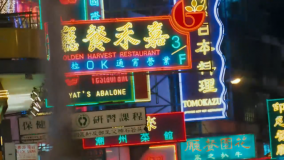
Neon lights on the streets of Causeway Bay. Scenes from Young and Dangerous 1996, directed by Andrew Lau.
Below is the scene where the police arrived to investigate ugly Kwan’s death. One interesting point to note is that while in the movie the accident is said to occur in Causeway Bay, the actual site of shooting is Thomson Road of Wanchai. A reason behind could be the similar structure and atmosphere of the two spaces with neon lights and high-density building characterizing the space and shaping the atmosphere. Afterall, A “region” is the space created by an interaction- and the neon-lit areas with protagonists’ adventures is what forges the spatial experience in the movie. and high-density building characterizing the space and shaping the atmosphere. Afterall, A “region” is the space created by an interaction- and the neon-lit areas with protagonists’ adventures is what forges the spatial experience in the movie.[2].
When comparing to recent years, the neon-lit area is gradually transformed under government light pollution regulations and development pressure.[3] Most neon lights in the same street were torn down and replaced by more environmentally friendly and cheap LED advertising lightboxes, contributing to the modernized spatial arrangement. The dying craft of neon lights that once animated Hong Kong’s cityscape as portrayed in Young and Dangerous thus becomes a neon-free zones. In addition, streets of Wanchai are no longer occupied by drunk and violent gangsters as portrayed in the movie, but many shops have been replaced by more casual bars or even chain restaurants like the Subway in the photo below with occasional old-style nightclubs, reflecting the disappearance of a distinctive Hong Kong culture.
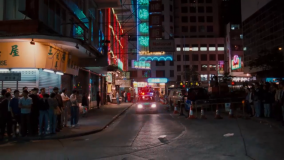
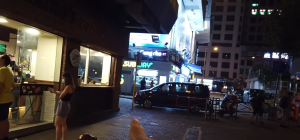
Modern infrastructure: disappearance of neon-lights. Left: Thomson Road, Wanchai. Scenes from Young and Dangerous 1996, directed by Andrew Lau. Right: Thomson Road, Wanchai. Photo credit: HERBEFACE, YouTube [4]
Another element worth noticing in the “space” of Hong Kong streets is the narrow and dim alleys that seeps through in between the dazzling shops and congested pedestrian walking. In the movie, Chan Ho Nam confronted Ugly Kwan in an alley of O’brien Road, Wan Chai, leading to the grand finale as the villain died from gunshot. Through dim lighting, air-conditioning units hovering and piled up bamboo basket creating spatial oppression and a sense of suffocation this alley is portrayed as an unseen corner of the city that conceals the underground activities from the radiance and enchantment of the streets. When comparing reality to the film, the actual site displays a similar creepy and nerve-wrecking atmosphere with minimal passerby and discarded waste, which is probably why the film was shoot here, with alterations of the lightings to establish a colder blue color tone hence build tension.
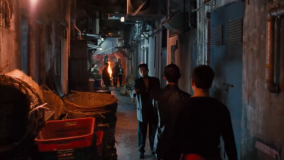
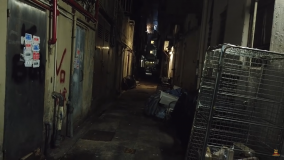
Dark alleys as hidden corners of the city. Left: O’brien Road, Wan Chai. Scenes from Young and Dangerous 1996, directed by Andrew Lau. Right: O’brien Road, Wan Chai. Photo credit: HERBEFACE, YouTube[4]
Glamorous neon-lit streets and dark alleys both are components on the exact same street, yet portraying very different atmospheres for different scenarios to take place. This fully utilizes the ideas of contrast to illustrate different sides of Hong Kong with perception of space amplified by filming in a first-person perspective, shaping the richness of the movie.
Kwan Yin Kiu 3035934391
Notes:
[1] De Certeau, M. (1984). Walking in the City. In The Practice of Everyday Life (pp. 91-110), translated by Steven Randall. Berkeley: University of California Press.
[2] De Certeau, M. (1984). Spatial Stories. In The Practice of Everyday Life (pp. 115-130), translated by Steven Randall. Berkeley: University of California Press.
[3] M+, West Kowloon Cultural District, Hong Kong’s Neon Signs – Then and Now.
[4] HEBEFACE, “靚坤之死與灣仔槍神發跡地.東漫酒吧存在嗎?| 港產片聖地.古惑仔系列#1” (2020)
You had done a comprehensive investigation in terms of film information, visualization techniques, and set design. Also, I appreciate your detailed comparative analysis of the scenes of neon signage, street and corridor. Nevertheless, I would encourage you to strengthen your fieldwork by expanding reference resources, like news, documentary, etc. Furthermore, it would be ideal if can continue your discussion based on the concept of “voyeurs” and “walkers”.